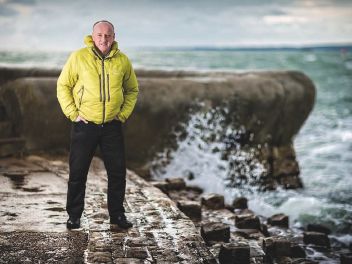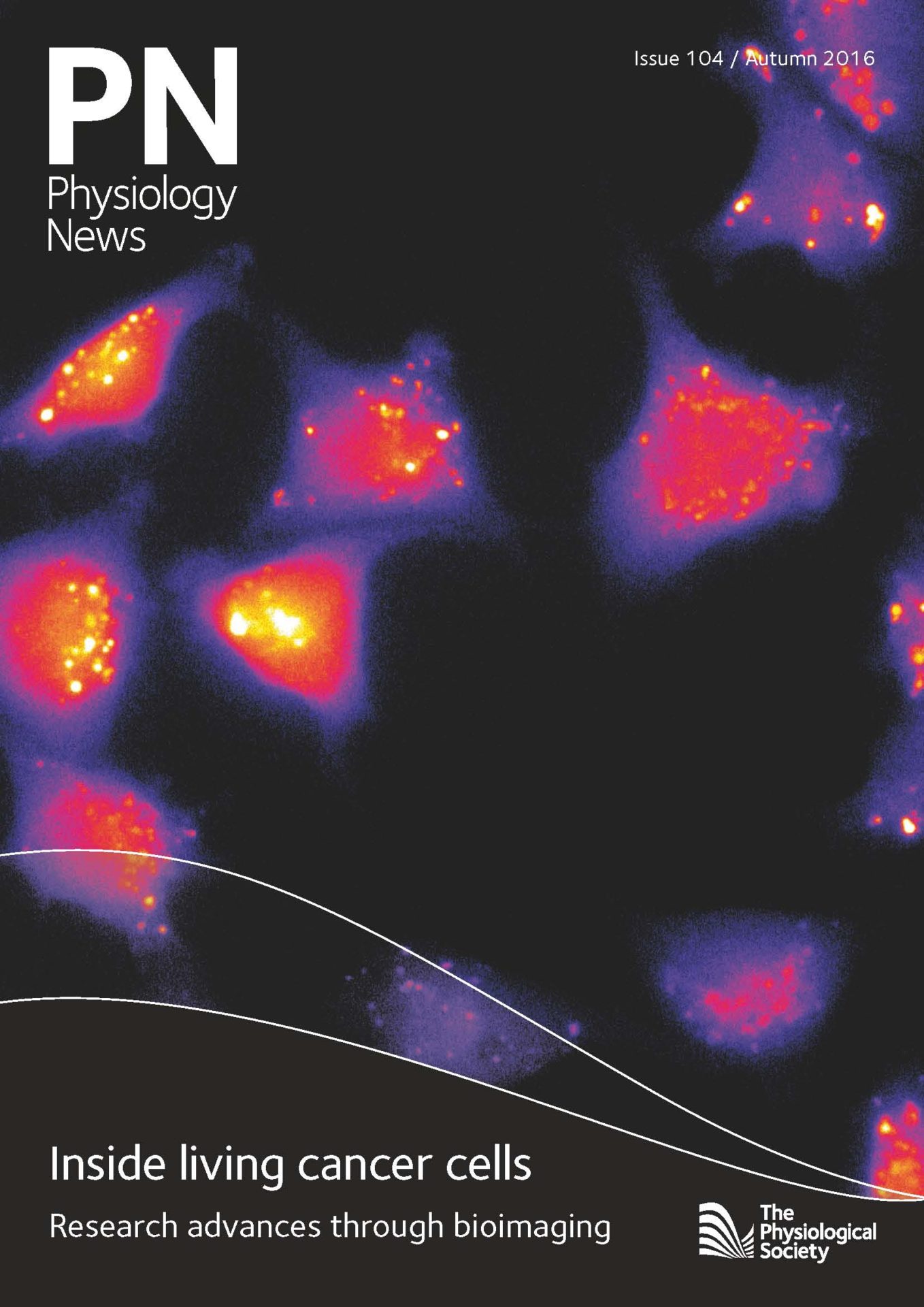
Physiology News Magazine
Cold, Wet & Nasty
The new Editor-in-Chief of Experimental Physiology talks about his research background in immersion–related death
News and Views
Cold, Wet & Nasty
The new Editor-in-Chief of Experimental Physiology talks about his research background in immersion–related death
News and Views
Mike Tipton
Extreme Environments Laboratory, Department of Sport & Exercise Science, University of Portsmouth
& Editor-in-Chief of Experimental Physiology
https://doi.org/10.36866/pn.104.18
I am delighted to be taking over this important journal from October 2016, after shadowing outgoing Editor-in-Chief Paul McLoughlin. EP recently published my G.L. Brown lecture (Tipton, 2015), although this was not part of the deal!
I have spent a large proportion of my career trying to help reduce the global burden of immersion-related deaths. The latest WHO estimation, probably an under-estimation, is that about 42 drownings occur per hour around the planet. Drowning is the second most common cause of accidental death in most countries; in the UK we lose a child a week and between one and two adults a day to drowning. Our contribution has been to try and understand the physiological and pathophysiological responses evoked by immersion. This has also involved working closely with important end-users such as Surf Lifesaving GB, the Royal National Lifeboat Institution, the Royal Life Saving Society, the Fire & Rescue Service and Her Majesty’s Coastguard.
My interest in extreme environmental physiology started with the King’s College, London MSc. in human and applied physiology in 1982. It involved visiting a wide variety of research centres. It was during a visit to the Institute of Naval Medicine in Gosport that I became really interested in thermoregulation, in particular how it related to survival in the sea. Dr Frank Golden was running an experiment that involved swimming for up to 20 minutes in water at 5°C wearing normal clothing; I vividly remember the cold-pain and respiratory drive associated with entering the water!
A lifelong friendship and collaboration with Frank Golden followed until his death in 2014, and a profound interest in how and why change stimulates the body, specifically the dynamic response of cutaneous thermoreceptors. When we started, and as a result of the Titanic disaster, the widely-held belief was that hypothermia (deep body temperature <35°C) was the major threat presented by immersion in cold water (thermoneutral water temperature in which you can sit without heating or cooling is 35°C. Cold water has no strict definition but is generally regarded as being below 15°C).
Our early work identified ‘cold shock’ – the cardio-respiratory responses evoked by sudden cooling of the skin – as the first and greatest threat to those immersed in cold water, with the pathological outcome being drowning rather than hypothermia (Tipton, 1989). Further mechanistic work into the early responses to immersion, hypothermia, circum-rescue collapse and the efficacy of basic life support with immersion victims, was complimented by research looking at mitigating the threat associated with cold shock by physiological and technological means. This included studies into cold habituation, and the development of both the first helicopter underwater emergency breathing system for offshore oil industry passengers in the UK, and an ‘integrated survival system’ for those flying over water in helicopters (Tipton et al., 1995). More recently we have looked at the mechanisms that might act as the pre-cursor to sudden cardiac death on immersion in cold water as well as other circumstances, including ‘Autonomic Conflict’ – brought about by the coincidental and conflicting acute activation of the cardiac components of the cold shock response (tachycardia) and diving response (bradycardia) (Shattock & Tipton, 2012). We are currently exploring this topic further in collaboration with Prof Mike Shattock’s cardiology group at King’s College.
It’s not all doom and gloom; part of our work has considered why some individuals, particularly children and small adults, occasionally survive long periods of submersion – the current ‘record’ is 66 minutes of submersion with complete recovery. Our proposed mechanism involves selective brain cooling caused by the two minutes of underwater breathing (heat exchange) associated with the drowning process. This is not just of academic interest; search and rescue organisations want to know how long they should search, particularly when they are at risk themselves. The answer seems to be up to 30 minutes when the water is warmer than 6°C and up to 90 minutes when it is fresh water and colder than 6°C (Tipton & Golden, 2011).

My enthusiasm for integrative physiology has also led to research aimed at investigating whole body integrative responses to environmental stressors, as well as a call for more multi-environmental stressor studies and studies on cross adaptation (Tipton, 2012). Like many other areas, those working in extreme environmental physiology tend to become pigeon-holed as experts in ‘cold’ or heat’ or ‘altitude’; occasionally it is good to step back and look at what happens when these stressors combine acutely and chronically, as they do in the natural world. Other work has focused on cold injury, heat and hypoxia as well as physical employment standards for those working in extreme environments. The common approach has been to gain an understanding of the basic physiology underlying environmental hazards, and use this knowledge to select, prepare and protect those confronting
these hazards.
I am delighted to be taking over as EiC of EP from Paul; he has done a selfless, first class job over the last five years. I think it will be a challenging and interesting job at a challenging and interesting time for science and scientific publishing. The charge (in every sense) towards open access publishing and an increase in the number and type of journals brings competition and raises fundamental questions about the communication, veracity and reproducibility of scientific findings. There has also been a shift in where physiology is practised, from medical schools to other university departments and institutions. On my travels I see physiologists doing excellent work in a wide range of circumstances including for elite sport, the military and different industries. Sir Peter Medawar once said that the dinstinction between ‘pure’ and ‘applied’ science is false. There are only two types of science; ‘good’ and ‘bad’. In such times of change we must continue to be innovative and responsive in helping scientists, wherever they ply
their trade, to communicate their high quality findings.
EP has many strengths: it has a long and distinguished pedigree; it has a reputation for excellence; it is a product of, and therefore closely associated with, the Physiological Society; it has high quality sister publications. It is these attributes that attracted me to the position of EiC and which I hope we can use to ensure that EP becomes the journal of first choice for the increasingly diverse family of scientists undertaking first class, novel physiological and pathophysiological experimental research into homeostatic and adaptive responses in health and disease, exercise, ageing and, of course, environmental challenges. (http://physoc.onlinelibrary.wiley.com/hub/journal/10.1111/(ISSN)1469-445X/aims-and-scope/read-full-aims-and-scope.html).
References
Tipton MJ (2015). GL Brown Lecture: ‘Extreme Threats’ Environmental extremes: origins, consequences and amelioration. Experimental Physiology. http://onlinelibrary.wiley.com/
doi/10.1113/EP085362/full.
Tipton MJ (1989). The initial responses to cold-water immersion in man. Editorial Review, Clinical Science 77, 581-588
Tipton MJ, Balmi PJ, Bramham E, Maddern T & Elliott DH (1995). A simple emergency underwater breathing aid for helicopter escape. Aviation Space & Environmental Medicine 66, 206-11
Shattock M & Tipton MJ (2012). ‘Autonomic conflict’: a different way to die on immersion in cold water? Journal of Physiology 590(5) (Pt 14), 3219-30
Tipton, M. J. & Golden, F. St.C. (2011) Decision-making guide for the search, rescue and resuscitation of submerged (head under) victims. Resuscitation 82, 819-824
Tipton MJ (2012). A case for combined environmental stressor studies. Extreme Physiology and Medicine. doi:10.1186/2046-7648-1-7
